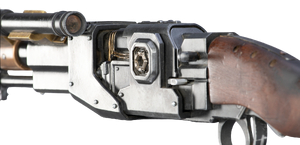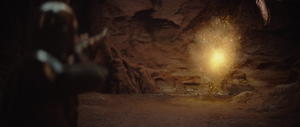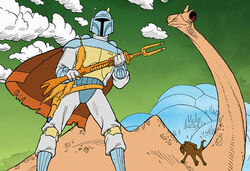| | |
- "That's one impressive weapon."
- ―Greef Karga
The Amban phase-pulse blaster, also known as an Amban sniper rifle, was a type of disruptor sniper rifle used by the Mandalorian bounty hunter Din Djarin. The weapon was capable of electrocuting opponents as well as completely disintegrating targets. It was also capable of listening to conversations at least a house away. Djarin used the deadly weapon to great effect during his bounty hunting career.
Description[]

The power cell port on an Amban snipe rifle
Manufactured by Amban Arms Corporation,[1] the Amban phase-pulse blaster was a modified sniper rifle[8] with a long barrel and a brown stock.[2] It was tipped with a fork-shaped resonator and a specially-calibrated visual scope. It could deliver a paralyzing electrical pulse at close range, and at long range, it could disintegrate organic matter on contact.[8]
The firearm was calibrated to fire a shock of anywhere from 50,000 to 500,000 volts. It could incapacitate most species. Used against more massive creatures, the stun feature was little more than a painful annoyance, like a sudden pinching sensation. On its highest setting, one blast would send a ionic pulse reverberating through a lifeform's essential systems. Contact with living matter vibrated the molecules so violently that the jolt and subsequent burst of released energy tore the target to shreds.[1]

The target of an Amban phase-pulse blaster would be disintegrated (a Trandoshan falls to Din Djarin's Amban, pictured).
A shower of sparks, charred flesh, and shreds of clothing were frequently all that was left, making victim-identification extremely difficult. For this reason, bounty hunters only used the rifle's highest setting as a last resort when hunting fugitives, as they could not claim success without at least the trophy of the intact head of their prey.[1]
History[]
From Pagodon to Nevarro[]
In 9 ABY,[9] the bounty hunter Din Djarin used this rifle on several missions. On his expedition to claim the bounty on the Mythrol on the planet Pagodon, he used the taser function on a Ravinak that attacked his ship, the Razor Crest.[2]

Djarin aims his Amban phase-pulse rifle
After being commissioned by the Client to acquire an asset known as Grogu on the planet Arvala-7,[2] Djarin used it as a scouting scope upon his arrival and wielded the rifle later to combat several Trandoshan bounty hunters who were seeking to claim his bounty. When Djarin discovered that Jawas had stripped his ship for parts, he fired on them from a distance, disintegrating several members of their group. When Djarin was forced to retrieve a mudhorn egg in return for parts to repair his ship, his disruptor rifle became inundated with mud which rendered it useless against the large creature.[10]
Before rescuing Grogu, Djarin used his pulse rifle to listen in on a conversation between the Client and Dr. Pershing. Djarin later used the weapon's taser function on an Imperial remnant stormtrooper while rescuing Grogu from their compound. However, after crossing the Client, Greef Karga and members of the Bounty Hunters' Guild came after him, ambushing him in the middle to the street. When Djarin was pinned down, several hunters advanced on him, but Djarin used the weapon to disintegrate several of them, causing the survivors to take cover. Djarin continued to fire before escaping with the help of the Tribe.[4]
Djarin's continued adventures[]

Over the course of his journey with Grogu, Din Djarin continued to make use of his Amban phase-pulse blaster until its destruction.
While defending a human tribe's village on Sorgan, Djarin used the weapon against an invading Klatooinian tribe. When the Klatooinian AT-ST Raider failed to activate their trap, he gave the rifle to his new comrade, the former shock trooper Carasynthia Dune, who then jumped into the pond and fired at the walker in order to bait it into their trap.[5]
Djarin also utilized the taser function of the weapon to electrocute the insides of a krayt dragon, effectively forcing it to open its mouth after engulfing Djarin, allowing him to escape from the stomach of the beast.[6]
The scouting scope was used by Djarin on the woods of Corvus while seeking for Ahsoka Tano.[7]
The rifle was aboard the Razor Crest on Tython while Djarin took Grogu to an ancient stone temple of the Jedi. During a subsequent encounter with Moff Gideon's remnant Imperial forces, Gideon shot Djarin's ship with an orbital laser blast from his light cruiser, destroying the ship and the rifle.[11]
Cold War era[]
By the time of the Cold War, a rifle was known to have come into the possession of Dok-Ondar and was displayed alongside a Mandalorian helmet in Dok-Ondar's Den of Antiquities.[12]
Behind the scenes[]

The Amban rifle first originated in The Star Wars Holiday Special.
The Amban sniper rifle first appeared in Chapter 1 of the 2019 Disney+ television series The Mandalorian,[2] which aired on November 12, 2019.[13] However, it traces its design back to the weapon of Boba Fett in the animated segment of 1978's The Star Wars Holiday Special, the first Star Wars television property and the first appearance of Mandalorian armor.[14] Its initial appearance in The Mandalorian pays homage to the Holiday Special, being used to ward off a subterranean beast (a ravinak in The Mandalorian versus a Panna dragon in the Holiday Special) attempting to devour a starship with the protagonists on board.[2][14]
Appearances[]
Non-canon appearances[]
Sources[]
Notes and references[]
- ↑ 1.0 1.1 1.2 1.3 1.4 1.5 Star Wars 100 Objects
- ↑ 2.0 2.1 2.2 2.3 2.4 2.5 2.6
 The Mandalorian — "Chapter 1: The Mandalorian"
The Mandalorian — "Chapter 1: The Mandalorian"
- ↑
 The Mandalorian in the Databank (backup link)
The Mandalorian in the Databank (backup link)
- ↑ 4.0 4.1 4.2
 The Mandalorian — "Chapter 3: The Sin"
The Mandalorian — "Chapter 3: The Sin"
- ↑ 5.0 5.1
 The Mandalorian — "Chapter 4: Sanctuary"
The Mandalorian — "Chapter 4: Sanctuary"
- ↑ 6.0 6.1
 The Mandalorian — "Chapter 9: The Marshal"
The Mandalorian — "Chapter 9: The Marshal"
- ↑ 7.0 7.1
 The Mandalorian — "Chapter 13: The Jedi"
The Mandalorian — "Chapter 13: The Jedi"
- ↑ 8.0 8.1
 Star Wars: Card Trader (Card: Amban Rifle - Topps' The Mandalorian - Series 1 - Tools of the Bounty Hunter)
Star Wars: Card Trader (Card: Amban Rifle - Topps' The Mandalorian - Series 1 - Tools of the Bounty Hunter)
- ↑ Star Wars: Timelines dates the events of "Chapter 1: The Mandalorian" and "Chapter 16: The Rescue" to 9 ABY. The events of Chapters 1–16 must therefore also take place in 9 ABY, and the events of Chapters 17–24 must take place around that year as well.
- ↑
 The Mandalorian — "Chapter 2: The Child"
The Mandalorian — "Chapter 2: The Child"
- ↑
 The Mandalorian — "Chapter 14: The Tragedy"
The Mandalorian — "Chapter 14: The Tragedy"
- ↑ Star Wars: Galaxy's Edge
- ↑ The Mandalorian Media Kit on Disney Direct-to-Consumer & International (archived from the original on March 15, 2023)
- ↑ 14.0 14.1 The Star Wars Holiday Special

